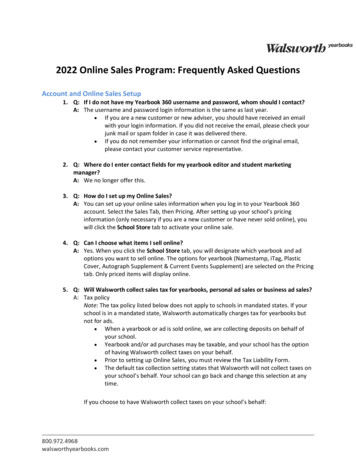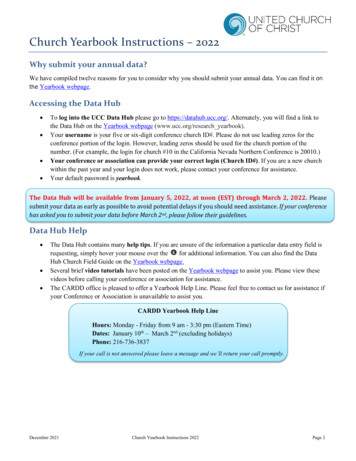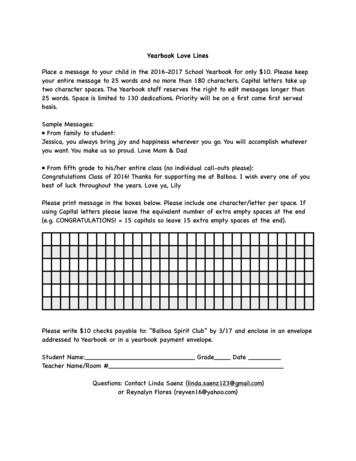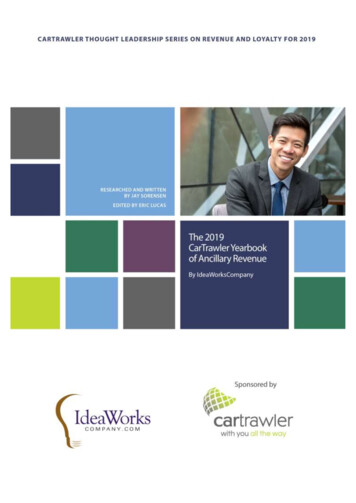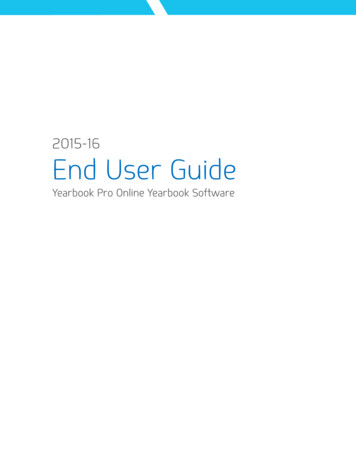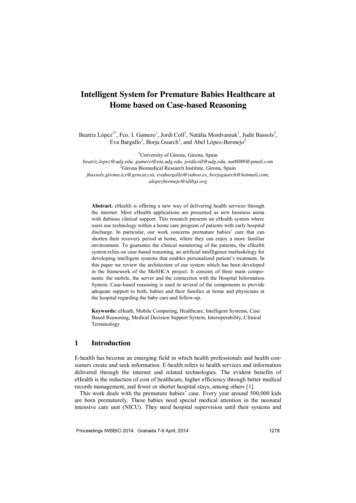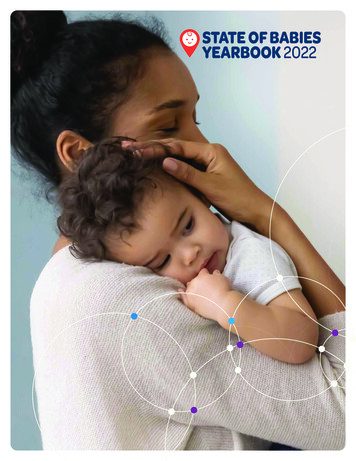
Transcription
STATE OF BABIESYEARBOOK 2022
The State of Babies Yearbook: 2022 is part of ZERO TO THREE’s Think Babies . ZEROTO THREE created Think Babies to make the potential of every baby a national priority.When we Think Babies and invest in infants, toddlers, and their families, we ensure astrong future for us all. Learn more at thinkbabies.org.TMZERO TO THREE works to ensure all infants and toddlers benefit from the family andcommunity connections critical to their well-being and development. Since 1977, theorganization has advanced the proven power of nurturing relationships by transforming the science of early childhood into helpful resources, practical tools and responsivepolicies for millions of parents, professionals, and policymakers.The data and indicator analysis in the Yearbook are powered by Child Trends, thenation’s leading nonprofit research organization focused exclusively on improving thelives and prospects of children, youth, and their families. For 40 years, decision makers have relied on the organization’s rigorous research, unbiased analyses, and clearcommunications to improve public policies and interventions that serve children andfamilies.Author Credit: Kim Keating and Sarah Heinemeier, with contributions from Patricia Cole,Jim Bialik, Daniel Hains, and Mollyrose Schaffner; ZERO TO THREE (Yearbook)Renee Ryberg, Emily Maxfield, Yuko Ekyalongo, Pilar Stoeppelwerth, Priya Koushik,Gabriel Piña; Child Trends (Indicator Dictionary)Gabriel Piña, Renee Ryberg, Emily Maxfield, and Priya Koushik; Child Trends(Methodology)
Table ofContentsINTRODUCTIONTHE 2022 YEARBOOK IN CONTEXT8Making the Case10Making Meaningful Change Through Strategic Use of Data13ABOUT THE 2022 YEARBOOKRevisiting the Indicators and State Ranking Methodology1516Refinement of indicators included in ranking16New and deleted indicators19Addition of a Puerto Rico profile20Enhancement of website and resources20Building on Previous Editions21Update of RAPID Survey Project data21Renewed commitment to advancing equity through data21Ongoing call for better data collection and reporting222022 YEARBOOK FINDINGS3523How States Compare23A Profile of America’s Babies26Key Findings by Domain29Good Health- Health care access and affordability- Medicaid expansion- Uninsured babies in families with low income- CHIP Maternal Coverage for Unborn Child option- Medical home- Extension of Medicaid coverage for pregnant women- Policy recommendations and related actions3031313132323233- Nutrition- Babies ever breastfed/breastfed at 6 months- WIC coverage- Policy recommendations and related actions34343435- Maternal Health- Late or no prenatal care received- Maternal mortality (deaths per 100,000 live births)- Mothers reporting less than optimal mental health- Policy recommendations and related actions3636363737State of Babies Yearbook: 2022 stateofbabies.org
Table ofContents continued- Child Health- Babies born preterm- Babies with low birthweight- Infant mortality rate (deaths per 1,000 live births)- Preventive medical visits- Vaccinations- Medical home- Effects of COVID-19 on preventive care- Policy recommendations and related actions- Infant and early childhood mental health- Social-emotional screening of young children- Medicaid coverage of IECMH services- Effects of COVID-19: RAPID findings onSocial-emotional Health- Policy recommendations and related actions- State SpotlightStrong FamiliesKey FindingsMain Section: Subsection4242434343454849- Basic Needs Support- TANF benefits receipt among families in poverty- Crowded housing- Effects of COVID-19 pandemic on Basic Needs- Policy recommendations and related actions- Related federal policy actions and state opportunities494950525454- Child well-being and resilience- Family resilience- Two or more ACEs- Removed from home- Policy recommendations and related actions- Related federal policy actions and state opportunities555556565757- Supportive Policies59- Paid family leave59- Paid sick time that covers care for child59- TANF work exemption59- State Child Tax Credit60- State Earned Income Tax Credit60- Policy recommendations and related actions60State Spotlight439393940404141414260
Table ofContents continuedPositive Early Learning ExperiencesKey Findings- Elements that support child care quality- State standards for infant and toddler care- Adult–Child ratio requirements- Group size requirements- Teacher qualifications- Infant/Toddler professional credential646465656565- Early Care and Education opportunities- Parent reads to baby every day- Access to early learning programs- Income-eligible infants/toddlers with EHS access- Infants/Toddlers in CCDF-funded care- Effects of COVID-19 on child care666666666667- Policy recommendations and related actions- Related federal policy actions and state opportunities6869- Early Intervention and Prevention services- Developmental screening received- Infants/Toddlers receiving IDEA Part C Services- Policy recommendations and related actions69697070- State Spotlight71APPLYING YEARBOOK DATA74Guidance for Reviewing the Data75Giving Advocates the Tools to Connect Data to 2APPENDICES85Appendix A: Summary of Indicator Values86Appendix B: Indicator Dictionary91Appendix C: Methodology142Appendix D: State Median Income150Appendix E: Pathways for Making Change152State of Babies Yearbook: 2022 stateofbabies.org
IntroductionThe state in which a baby is born and lives in their first 3 years can make a difference in whether theyhave a strong start in life. But even more critical than the apparent geographic differences are thedisparate experiences among babies of different races, ethnicities, and income levels, with inequitiesstarting even before birth. Often driven by systemic racism, these disparities persist even in states wherebabies overall are doing better than in other states. A nation that tolerates grave disparities and does notprize equity cannot be strong in the long term. There are many issues in our nation about which there isagreement on investing in fundamental public goods that benefit society as a whole (e.g., public education, food standards, and transportation safety). However, we have yet to place similar value on a strongnational agenda for a foundational prenatal to 3 period and, as a result, support for this period is unevenand inequitable both in national policy and across states.Telling the story of babies is thus more important than ever. The data included in the State of BabiesYearbook: 2022 help policymakers understand the indications that too many babies face risks that canundermine development and therefore their ability to reach their potential—in other words, what to payattention to. The data also can help policymakers think strategically about progress—the actions that canbe taken to create meaningful and sustainable change for all families with young children.Each day, more than 10,000 babies are born in America, with many entering a world in which they andtheir families face immediate challenges. In the absence of a national agenda that equitably prioritizeshealth, development, and basic economic security, there is tremendous variation across states in howand the extent to which babies and families are prioritized. Most notably, national and state data onmaternal mortality, infant mortality and other birth outcomes, food insecurity, and material hardship allsuggest that many of our nation’s babies are at risk of being left behind. As this Yearbook will highlight,we as a nation need to improve our approach to early life policies and prioritize them as prudent investments that benefit our nation as a whole.Grounded in the science of early childhood development, the State of Babies Yearbook bridges the gapbetween science and policy by providing national and state-by-state views of how America’s babies andtheir families are faring, according to more than 60 indicators in ZERO TO THREE’s policy framework ofGood Health, Strong Families, and Positive Early Learning Experiences. Indicators in each domain examine child and family well-being, status and reach of programs and services, and the presence or absenceof key policies that are essential for healthy development. Data provided in the Yearbook can be used bypolicymakers, advocates, and all stakeholders in the lives of babies to identify and promote comprehensive policies that ensure all babies have a strong start and the opportunity to reach their full potential.6Introduction
14.4%The preterm birthrate for Black womenis 41% higher than thenational average.7State of Babies Yearbook: 2022 stateofbabies.org
The 2022 Yearbookin ContextThe release of the 2022 Yearbook occurs at a time whenthe nation is grappling for the third year with the health,economic, social, and emotional impacts of the COVID19 pandemic. As reported in our 2021 edition, while prepandemic data clearly showed the disparities and gaps inchild and family well-being, the pandemic itself revealed thefragility and insufficiency of the many systems that shouldensure stability among the nation’s families, particularly thosewith young children during their critical first 3 years. Theimmediate effects of the pandemic—shutting down criticalsocial structures, such as child care, school systems, and keysegments of the economy—disrupted the lives of all families,but particularly those with young children. In the period sincethe pandemic’s onset, families have continued to struggleto adapt to the unpredictability of new variants of the virus,waves of increased infection rates, and the associatedfluctuations in stay-at-home orders, work patterns, andprotocols for safely interacting in communal settings.8IntroductionTheState of America’s Babies: 2022 Yearbook in Context
Analyses of the pre-COVID-19 datapresented in the Yearbook and thefindings of the multidisciplinary bodyof research being conducted amidthe ongoing pandemic, together withthe voices of families themselves, make clear theurgency of this moment for babies and families.This moment provides incredible impetus to finallycreate the comprehensive family policy our nationhas lacked. Due in great part to nationwide effortsto address the pandemic’s effects, this Yearbook’srelease occurs at a time when an unprecedentedculmination of events requires meaningful andlasting change to our nation’s systems—if we canmuster the political will to carry these efforts tofruition. This is a potentially transformational timein which the long-standing gaps in investmentsfor all babies and families can be reassessed andaddressed with policies, programs, and practicesthat value and address their needs.For all of these reasons, the State of BabiesYearbook: 2022 places new emphasis on preparing policymakers, advocates, and other keystakeholders to effectively review and apply thedata. This edition of the Yearbook contains newsections with specific guidance or suggestions forusing the data. This edition also tackles the needand strategies for building new advocates, advisors, and strategists. While the indicators themselves may be familiar, what creates urgency is ourcontext—our nation’s long neglect of the policiesthat build strong families and ensure healthydevelopment, the condition of our nation inrecovering from COVID-19, and our nation’s longterm strategy for health, economic security, andquality of life in an interconnected and changingworld. We hope the presentation of these sectionswithin the Yearbook helps jump-start or continueconversations on how to make change.COVID-19 has exposed or created stress fractures for families. A prominentexample that has been discussed in national media is the use of child care byworking parents. COVID closures and stay-at-home requirements revealedhow challenging it can be for families to balance work and family requirements.At the same time, COVID created challenges for our professional child caresystem. Increased turnover and challenges in recruiting new staff havecontributed to a lack of high-quality and affordable child care for families withinfants and toddlers. This lack of availability forces families to consider whetheror not a parent can remain in the workforce or how to access high-quality carefor their young children.9State of Babies Yearbook: 2022 stateofbabies.org
Making the CaseMeaningful investments in support of the first3 years of life, a time of babies’ rapid foundational brain development and social-emotionalconnections, pay dividends in addressing theimmediate needs of families, the reduction ofthe downstream use of safety net services, andthe generational change these policies can bring.Amounts invested early grow and can generatewealth and security later. Strategic investmentshave the power to generate jobs and security formany, with a ripple effect that brings value to bothdirect and indirect beneficiaries. The strategy is tostart with something small and watch it grow andflourish. The same is true for our babies.a strong foundation for the rest of their lives.When babies don’t get what their growing brainsneed to thrive because of a lack of resources oropportunities, they don’t develop as they should.This leads to lifelong developmental, educational, social, and health challenges. Nurturing aninvestment generates strength and security butrequires long-term vision and commitment. Let’sbe straightforward: We have enough science andresearch in place to know what works and how toinvest. The issue is not that we don’t know how tosupport babies and families—the issue is that we,as a society, are not yet willing to make a sufficient investment.The science is clear: Our brains grow faster in thefirst few years than any later point in life, formingmore than one million new neural connectionsevery second.i When babies have nurturing relationships, positive early learning experiences, andgood health and nutrition, those neural connections are stimulated and strengthened, layingIn this Yearbook the data on the well-being ofbabies and families make a powerful case for astronger and more equitable national agendaaround the first 3 years, which is very much a casefor ensuring well-being and stability for all babies.This case is grounded in five principles.PRINCIPLE 1: The first 3 years areeveryone’s issue. Think: babies!PRINCIPLE 2: All families wantto provide their babies thestrongest start.PRINCIPLE 3: Every family hasneeded, needs, or will need help.PRINCIPLE 4: Diversity becomesstrength.PRINCIPLE 5: Equity is apublic good.10The State of America’s Babies: 2022 Yearbook in Context
PRINCIPLE 1: This is everyone’s issue.The data presented in this Yearbook highlightareas in which young children and their familiesare struggling. We can use these data to communicate why infants and toddlers are everyone’sconcern. This issue will become increasinglyacute as, more and more, families that have beenoverlooked struggle in our polarized political andeconomic climate. Therefore, we must be proactive and specific in using data to clearly communicate how early childhood is a prudent investment,across any time frame. Namely: Thriving is a communal act. The more wenurture our neighbors and neighborhoods,the more we allow everyone in and across ourcommunities to prosper. Peace and prosperityfor all starts when we ensure we are meetingeveryone’s basic needs and allow everyone’shopes and aspirations to flourish. Family support is economic development.Family supports include a range of servicesthat are responsive to individual family needs.Affordable housing and medical care, familyfriendly work policies, high-quality childcare, tools for economic stability, and othersupports are critical for ensuring parents candevelop resilience or the ability to “bounceback” or weather crises such as the pandemic.Stable and resilient families contribute tostable and resilient communities, which areattractive to employers. Healthy communities start with healthybabies. A baby’s well-being is rooted in thehealth and wellness of the whole family andcaregiving community. Babies and familieswho live in safe neighborhoods with access toquality health care, early intervention services,and mental health supports, and who areless exposed to social-emotional stressors,may experience improved long-term healthoutcomes. Early care and learning generates longterm benefits. When we help our youngestexperience a strong start in life, beginningwith enriching early care and learning11State of Babies Yearbook: 2022 stateofbabies.orgopportunities, we are working to ensure theycan take full advantage of public educationand future advancement opportunities. Whenwe subsidize high-quality child care for eligiblefamilies, we help more parents to participate inthe workforce and support the early educationworkforce in our communities.PRINCIPLE 2: All families want to provide theirbabies the strongest start.Our discussion is firmly grounded in the beliefthat all families are doing the best that they canfor their babies. Parents are working with the toolsavailable to them to provide the strongest startin life for their babies. However, inequities in thebarriers or challenges experienced by familiesmay impact parents’ ability to give their babies allthe opportunities they need to reach their potential. These inequities stem from multiple factors,and some families have numerous challenges toaddress. Of particular concern are barriers thatare caused or fortified by systemic inequity (e.g.,endemic racism), especially when coupled withdifferential access to opportunities and power.And, as a society, we are increasingly attuned tothe fact that “opportunity” must exist not onlywith regard to employment, career, or income butalso with regard to health, hope, optimism, andlife-enriching experiences. We have to value theselast as necessities, not luxuries.
community health and welfare. Some of thechallenges reflect a family’s ability to connect toan available service for reasons of eligibility oravailability. In these instances, a family or childmay need a service that is not available to themin their community. Alternately, a family or childmay not afford a service or qualify for free orsubsidized service. Some challenges reflect afamily’s inability to engage with and benefit fromservices—lack of translation services or reliabletransportation, inability to get time off from one’semployer during service hours, need for nontraditional service days or hours, need for caregivingfor other family members while receiving service,implicit or explicit racism, or general insensitivityto needs are examples.There is no singular way to provide a strong startfor our babies. The diversity of family cultures, lifestyles, and approaches in our nation is a resourceto draw from in helping families realize the intentional parenting that nurtures babies and ensuresthey have the opportunity to grow into their fullpotential. As a society, we must become moreadept at partnering with parents to fully supporttheir efforts to promote their young children’sdevelopment. This support requires much morethan encouragement. True partnership requiresshared learning and respecting the voices anddiverse lived experiences of parents, and honoringtheir best intentions for their children, especiallythose who traditionally have been marginalized.PRINCIPLE 3: Every family has had, does have, orwill have a need for help.All families need help at some point, such asassistance caring for a sick child or other family member, help making ends meet, emotionalor mental support for the stresses of parentingand family life, or “just-in-time” support whenschedules or plans run amok. COVID-19 hasboth exacerbated and exposed challenges families face, and we do not yet know the full extentof the pandemic’s impact on our individual and12PRINCIPLE 4: Finding strength from diversity.Diversity is the core of America’s strength as anation as it is the wellspring that feeds innovationand creativity. As the Yearbook shows, diversity isthe hallmark of America’s babies today. We havemany diverse traits and experiences to draw fromwithin our communities that can assist familiesin deepening their resilience and adaptability.When we accept and welcome the fact that thereis no one right way to parent, give birth, providecare and nurturing for children, or respond to anindividual child’s needs, we foster dialogue aboutpolicies, strategies, and approaches that help parents adapt and respond to the challenges of beingparents. When we value different developmentalpathways for children and families, we create aricher environment for all children and incubateempathy, compassion, and a willingness to acceptsomething outside the bounds of our own personal experience. Our communities can be strongbecause they are diverse—not despite it.PRINCIPLE 5: Equity matters.Despite the importance of the first 3 years,opportunities to grow and flourish are notshared equally by all infants, toddlers, and families, reflecting past and present systemic racismand barriers to critical resources. Even beforethe COVID-19 pandemic, 2 in 5 babies lived infamilies without enough income to make endsmeet. Among babies of color, American Indian/Alaska Native, Hispanic, and Black babies wereThe State of America’s Babies: 2022 Yearbook in Context
disproportionately more likely to live in poverty.As the Yearbook data show, challenges created byCOVID-19 disproportionately affected these samefamilies.If our nation is to thrive, our policies must directlyaddress and promote equity. We must ensure thatpolicies remove barriers to health, well-being, andsuccess (based on family income, race and ethnicity, or geography, for example) so that familiesand individuals who disproportionately experiencethese barriers can focus on the work of health,well-being, and success. All families, everywhereand regardless of demographics, want to behealthy and successful. To truly address equitymeans meeting families where they are and listening to their voices in securing the supports theyneed. The Yearbook presents indicators that speakto not only the issues faced by babies and families on a daily basis, but also the broader impactof persistent challenges, experienced inequitablyacross families.Making Meaningful Change Through Strategic Use of DataThis Yearbook focuses attention on indicators of child and family well-being and policiesacross each of the nation’s states, the District ofColumbia, and, now, Puerto Rico.1 These dataallow states to review the latest publicly availabledata for each indicator and assess relative performance against other states. For each indicator,states can be ranked from best-performing toworst-performing. The national profile, as wellas disparate policies and indicators of well-beingand access to services across states, leads to anational policy discussion to ensure equity forbabies across the nation.The data included in this Yearbook help positionpolicymakers, advocates, and other stakeholdersto understand not only what to pay attention towith regard to support for babies and their familiesbut how to think strategically about progress—theactions that can be taken in a specific sequenceand at specific times to create meaningful andsustainable conditions for all families with youngchildren that truly enable young children to thrive.This is very much a conversation about equity,starting not with what we are willing to give butwith what individuals need.We don’t want you to just read this report. Wewant the data to help you develop a strategyfor change.But not every substantive change is a headline.In fact, we can influence meaningful change byunderstanding the change process and identifyingopportunities for improvements both large andsmall in scale.1For simplicity, the 50 states, District of Columbia, and Puerto Rico will bereferred to as “states” throughout the Yearbook.13State of Babies Yearbook: 2022 stateofbabies.org
Making change through strong engagement.Engagement and full utilization of servicesby parents and children is influenced byoutreach, accessibility, and appeal. Programadministrators can ponder how improvementsin community education, secondary supportsystems, and professional training might affecta parent’s willingness to use and respond toservices.These opportunities include: Making change through legislation andpolicy. The existence of programs is subjectto approval and funding from electedrepresentatives. Therefore, all stakeholders inthe lives of babies and families can advocatefor laws and policies that direct the funding ofnecessary services. Making change through improvementsin practice. They also can examine howimproving working conditions and support forservice professionals can nurture and sustainthose who are on the front lines of services.14The implementation of programs is subject toadministrative policy, or the statutes and regulations that guide practice. Policymakers, advocates,and community members can identify gaps andopportunities to improve statutes to ensure ongoing improvement in service delivery.The State of America’s Babies: 2022 Yearbook in Context
Making change through legislation and policyZERO TO THREE’s Policy Agenda lays out priority issues to ensure all babies have Good Health,Strong Families, and Positive Early LearningExperiences. As a complement to the PolicyAgenda, the data in this Yearbook fuel a review ofhow well we as a nation and individual states arefaring with regard to this commitment. The datain the Yearbook clearly show our nation’s commitment to families with young children has beeninadequate. Now is the time to push federal andstate policymakers to initiate broad and far-reaching structural changes in how we fund, regulate,and operate services that work to support familiesand communities.FEDERALZERO TO THREE’s Federal Policy Agenda,Recovery Begins With Babies and Families, wasprovided to the new Administration and the117th Congress as well as other policymakersand advocates. At the time of this Yearbook,there have been unprecedented efforts at thefederal level through President Biden’s BuildBack Better Act, proposal and the House-passedreconciliation bill incorporating much of that planto address many of the challenges reported in theYearbook’s pre-pandemic findings on indicatorsin our Good Health, Strong Families, and PositiveEarly Learning Experiences policy frameworkdomains.Together, Yearbook data and the supplemental real-time findings during the pandemic ofthe RAPID Survey Projectii point to the need forthese and other bold policy actions. For example, proposed legislation would directly addresspersistent racial and ethnic disparities in maternal mortality and negative birth outcomes thatthe Yearbook shows disproportionately affectBlack and American Indian/Alaska Native families.Yearbook indicators point to economic insecurityand inability to meet basic needs affecting manybabies and families. Pending legislation wouldexpand and strengthen economic and familysupports for the growing number of familieswith young children who struggle to meet basic15State of Babies Yearbook: 2022 stateofbabies.orgneeds (e.g., food security and housing stability).Finally, Yearbook data show few families receivingchild care assistance and low floors for quality inmany states. Proposed legislation would investin transforming the nation’s disjointed child caresystem—a vital component of our infrastructure—into a comprehensive system while increasing thequality and availability of child care for babies andtoddlers in families of all income levels, includingthose living in poverty or with low income forwhom quality care has been out of reach. Theseand other aspects of pending legislation will be ofimmediate and long-term benefit to babies andfamilies nationwide.As this report is published, the fate of theseproposals remains uncertain. But their existenceshows that the lack of a comprehensive familypolicy in the United States is a failure of will, not afailure of imagination.Now more than ever, we must have multiplearrows in our quiver for facilitating change. Thus, ifone door closes, other options for forward motionremain open. A more detailed description of eachof these approaches can be found in Appendix E.
STATEIndividual states also are creating or enhancingpolicies that reinforce state priorities for familiesand babies. Examples are provided below.Good HealthThe Yearbook highlights disparities in earlyadverse experiences as well as in birth outcomes,particularly for Black and American Indian/AlaskaNative infants. States are working to improvethe health of young children. California’s SB 428would require commercial health plans to includecoverage for adverse childhood experience (ACE)screenings as early as 2022. In Maryland, there isaction to use Medicaid to reimburse doula costsat childbirth. New Jersey is considering policiesthat address health care for low-income familiesand support doula services. New Jersey also isaddressing equity in health outcomes throughtraining and other professional support activities.Nevada is considering initiatives that would useMedicaid funds to cover certain prenatal costs andcosts related to breastfeeding.Strong Families:The Yearbook shows the gaps in meeting basicneeds and the need for supports such as homevisitation. Some states are working to expandthese supports. Alabama realized an increase inits First Teacher program while Connecticut isimplementing a Universal Home Visitation pilotproject. Minnesota is working to increase fundingand program flexibility in home visitation whileNew Jersey’s universal home visitation law wouldallow for at least one home visit after childbirth. InPennsylvania, new legislation would use Medicaidfunding to support home visitation (and doula)services. States also are addressing one of thelargest economic expenses for families: housing. California’s Bringing Families Home programwould address
The State of Babies Yearbook: 2022 is part of ZERO TO THREE's Think Babies TM.ZERO TO THREE created Think Babies to make the potential of every baby a national priority. When we Think Babies and invest in infants, toddlers, and their families, we ensure a strong future for us all. Learn more at thinkbabies.org. ZERO TO THREE works to ensure all infants and toddlers benefit from the family and
